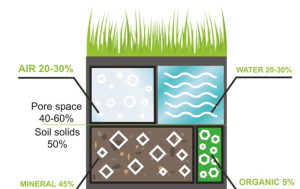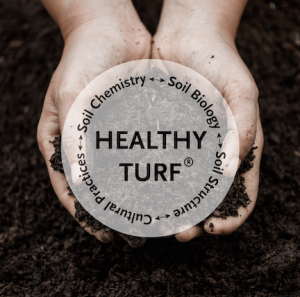What is Soil Compaction and Why is it Harmful to Grass Growth?
 Soil is made up of four essential components: minerals (sand, silt, clay, and minerals), organic matter (OM), air, and water. In an ideal soil structure, these components are balanced, creating the pore space necessary for grass roots to thrive.
Soil is made up of four essential components: minerals (sand, silt, clay, and minerals), organic matter (OM), air, and water. In an ideal soil structure, these components are balanced, creating the pore space necessary for grass roots to thrive.
Grass roots do not grow in dirt, they grow in the pore space between soil particles.
Why Pore Space Matters
Pore space determines:
- How water infiltrates, is retained, and drains from the soil
- How oxygen reaches plant roots and allows gasses to escape
- Where and how deep grass roots grow
When soil compaction occurs, these natural processes are disrupted, weakening turf health.
What is Soil Compaction?
Soil compaction happens when soil particles are pressed tightly together, reducing pore space. Compaction stresses turf by:
- Restricting root development
- Limiting water infiltration and drainage
- Reducing oxygen exchange
- Hindering nutrient uptake
The result is shallow root systems, nutrient runoff, soil erosion, and in severe cases, anaerobic soil conditions.
What Causes Compaction?
Soil compaction can occur both naturally and through human activity:
- Natural causes: heavy rainfall, snow loads, flooding
- Human causes: equipment use, overwatering, excessive foot traffic, poor lawn practices
Soils with high clay content and wet soils compress more easily and are especially prone to compaction.
How to Identify Soil Compaction
Visual Cues
- Pooling water: If water can’t penetrate the soil surface, roots won’t get the moisture they need.
- Thin turf: Often coupled with pooling water and overuse.
- Weeds: Dandelions and plantain thrive in compacted soil.
Dandelions: Strong central tap root penetrates compacted soil.
Plantain: Shallow fibrous root system spreads outward, creating its own pore space.
Simple Testing
- Walking test: If the lawn feels like walking on a hard floor, it’s likely compacted.
- Screwdriver test: Use a flathead screwdriver (marked at 1 ½” and 3”) to press into the soil. Difficulty inserting indicates compaction.
- Penetrometer: A specialized tool mimicking root penetration, measuring soil resistance. The shaft will generally have graduations every 3 inches to help determine the depth of compaction.
How to Relieve Soil Compaction
There are natural factors we can’t control, but cultural practices and organic turf care can reduce compaction and restore soil health.
Soil Care Basics
- Soil testing: Maintain pH between 6.7–7.0 and a Ca:Mg ratio of at least 7:1.
- Calcium: Improves plant cell walls and soil structure.
- Organic fertilizers and amendments: Feed soil biology to keep microorganisms active and aerating naturally.
Cultural Practices to Address Compaction

- Core aeration: Best method to mechanically create pore space. Do this in early spring and early fall when grass is actively growing.
- Overseeding: Protect bare soil by adding new grass seed.
- Watering: Water deeply and infrequently, preferably in the morning.
- Mowing: Avoid mowing when soil is wet, and vary mowing patterns.
- New lawn installations: Limit heavy equipment use, store topsoil properly, and avoid working with wet soil.
- Public spaces: Restrict traffic to designated paths to reduce wear and compaction.
Conclusion
Healthy turf depends on soil with enough pore space for deep, strong root systems. Compaction prevents grass from accessing the air, water, and nutrients it needs to thrive. By combining cultural practices like core aeration, proper watering, and overseeding with organic turf care solutions, you can reduce compaction and encourage long-term soil and grass health.
When you prioritize soil health, you set the foundation for a lush, resilient, and naturally beautiful lawn.
